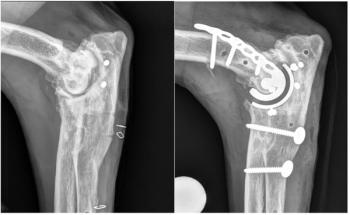
Myofascial pain syndrome: the next big thing (Proceedings)
Probably the most common condition associated with osteoarthritis, post-surgery and musculoskeletal abnormalities. Yet, it is rarely taught in veterinary university settings, few practitioners even know of its existence, all despite the fact that muscles compromise half of an animal's body weight.
Overview
Probably the most common condition associated with osteoarthritis, post-surgery and musculoskeletal abnormalities. Yet, it is rarely taught in veterinary university settings, few practitioners even know of its existence, all despite the fact that muscles compromise half of an animal's body weight.
Myofascial pain is often misdiagnosed as tendonitis, joint degradation, muscle strain, inflammation or damage to peripheral nerves. Even in human medicine, where good solid research articles abound, there is resistance in the medical community to view myofascial pain as "mainstream."
It was brought to the forefront of human medicine by Drs. Travell and Simons.
Terminology and abbreviations
1. MTrP(s) Myofascial Trigger Point(s)
2. DN Dry Needling – The use of an acupuncture needle in the treatment of a trigger point
3. Taut Band – The affected taut muscle which contains the trigger point
4. Twitch Response – The characteristic twitch a muscle displays when a needle is inserted into a trigger point, or a taut band is snapped during palpation
5. Jump Response. Menace Response – The reactions displayed by an animal when a trigger point is palpated
Pathophysiology
1. There are several components that make up the pathophysiology of the trigger point. They are:
a. The motor endplate component
i. The motor endplate is where alpha motor neurons synapse with target muscle fibers
ii. These neurons cause the release of acetylcholine (ACH) which through a series of reactions causes myosin and actin to bind causing sarcomere contraction
iii. A decrease in acetylcholinesterase results in the inability of the contraction to "release."
b. The motor component
i. Muscle contraction compresses local sensory nerves, which reduces the axoplasmic transport of molecules that normally inhibit ACH release
ii. Muscle contraction also compresses local blood vessels resulting in a decrease in oxygen at a time when the muscle contraction requires an increase in the amount of oxygen
iii. This results in a rapid depletion of ATP resulting in an energy crisis
iv. ATP is needed to turn off ACH release. This results in a vicious cycle of continued muscle contraction and ATP depletion
c. The sensory component
i. Micro-sampling from within the MTrP revealed elevated concentrations of inflammatory substances including protons, bradykinin, serotonin, substance P, norepinephrine, tumor necrosis factor and interleukin-1b
ii. Persistent barrage of nociceptive signals from MTrPs may eventually cause central sensitization leading to allodynia or hyperalgesia, which may be permanent
d. The autonomic component
i. Autonomic phenomena associated with MTrPs may include vasoconstriction, vasodilation and pilomotor activity
ii. The autonomic nervous system may indierectly exacerbate MTrP formation via viscerosomatic reflexes
Theory to therapy
1. Deep digital pressure? Increases compression and worsens the condition
2. Affected muscles that cross an articular surface can reduce the functionality of that joint via decreased muscle length
3. Needling with botulinum toxin type A prevents release of Ach
4. Dry needling in animals is very effective.
Why that muscle?
1. Muscles most commonly affected are from both the flexor and extensor groups
a. Rectus femoris, Sartorius and surrounding mm
b. Tensor Fascia latae mm
c. Vastus mm group
d. Triceps m
e. Iliopsoas m
f. Multifidi mm
g. Infraspinatus m
2. Any muscle can have a trigger point
3. Cinderella Hypothesis
a. Works on the idea that within any muscle, certain fibers are always the first recruited during contraction and the last released during relaxation
b. This is very significant during activities that do not require full muscle contraction, but only subtle contraction
i. Example: Chronic cruciate rupture of hip dysplasia results in a very slight and subtle contraction to take just a little weight off the affected leg.
Implications of MTrPs
1. Once developed, trigger points last forever
a. Active trigger points cause pain, latent points ar just waiting in the wings to start up again
2. Many orthopedic procedures appear to fail even though the surgery went well..MTrPs prevent the animal from using the leg properly
3. Recent study of fibromyalgia in people described a cognitive dysfunction called "fibro-fog" where there is a decreased capability of everyday cognitive activities
a. Could we be ignoring this as a reason why many old arthritic dogs appear out of it?
Use in veterinary medicine
1. Dry needling seems to be the most efficacious treatment in veterinary medicine
2. Palpation of taut bands just requires practice practice practice.
3. Needling technique is different than needle placement for acupuncture
Steps in finding and treating MTrPs
1. Palpate muscles to locate taut bands and trigger points. Look for classic signs of painful palpation. Depends on dog and personality...licking lips, turning and looking, vocalization, jump, menace response
a. Palpation techniques vary with the muscle being palpated and include:
i. Pincer technique
ii. Single finger or flat hand technique
iii. Spade hand palpation
2. Dry needling the points. A twitch response tells you have "nailed it."
a. This is a spinal reflex
b. MTrPs are often clustered together. You keep pecking away a the same spot until it stops twitching
c. The same needle can be re-sheathed and used over and over until it starts to feel dull or bend
d. There is a different feel between normal muscles and those with taut bands when you put a needle in them. The taut band has a heavy "clay" feel to it. Some people describe it as feeling "gritty."
3. Therapeutic lasers can be used on the trigger points as a "shotgun" therapy. You will never find and treat every single trigger point with a needle. The laser will provide some relief of the energy crisis.
Recommended Reading
Myofascial Trigger Points. Pathophysiology and Evidence-Informed Diagnosis and Management by Jan Dommerholt and Peter Huijbregts
Newsletter
From exam room tips to practice management insights, get trusted veterinary news delivered straight to your inbox—subscribe to dvm360.






